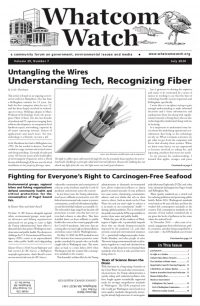by Lorraine Loomis
The greatest obstacle to salmon recovery in western Washington is that we continue to lose salmon habitat faster than it can be fixed and protected. Until that changes, salmon populations will continue to decline.
That’s why we are encouraged by Gov. Jay Inslee’s leadership to challenge the status quo and take an important step needed for salmon recovery.
The potentially groundbreaking move came last November at the annual state/tribal Centennial Accord meetings. Created in 1989 to mark the state’s 100th anniversary, the gathering brings together the tribes and state in a government-to-government forum to address issues of mutual interest such as health care, education and natural resources.
As part of the 2019 Centennial Accord commitments, Inslee recognized the importance of healthy riparian, or streamside, areas as critical to both our region’s salmon recovery efforts and climate change resiliency. In a bold move, he directed his state natural resources agencies to develop a consistent approach for uniform, science-based riparian management and guidance to protect salmon and their habitat.
We know what needs to be done, so let’s stop debating and do it.
Riparian habitat is among the most important for salmon. Shade from trees and other vegetation help keep water temperatures low to aid salmon survival at all life stages. Riparian vegetation also filters harmful runoff and slows erosion to prevent eggs from being smothered. When trees fall into a stream, they help create diverse habitat such as pools where salmon can rest, and gravel spawning beds that are crucial to reproduction.
Stream temperatures near 70 degrees can be lethal to salmon. According to state data, more than 1,700 miles of streams and rivers in western Washington do not meet state or federal water quality standards for water temperatures.
The best way to protect salmon habitat is to establish streamside buffers.
An approach used for many years to establish buffer widths in state and national forests is called site potential tree height. That’s the maximum height of the tallest dominant species of trees — usually 200 years or older — in a streamside location. When converted to buffer widths, the distance ranges from about 100 to 300 feet depending on soil conditions, rainfall and other factors.
Since 2004 tribes have documented the decline of salmon habitat throughout western Washington in the State of Our Watersheds Report. It details habitat conditions and limiting factors for salmon recovery throughout western Washington. The updated 2020 report will be completed this summer.
We are also advancing solutions to support salmon recovery and treaty rights protection through gw∂dzadad, our strategy for protecting and rebuilding salmon habitat that takes its name from the Lushootseed word that means “Teachings of our Ancestors.” The reports are available at: https://geo.nwifc.org/sow/ and https://nwtreatytribes.org/habitatstrategy/
We know the status quo isn’t working when it comes to salmon recovery. We know what the science says needs to be done, and we know that we must move forward together.
Gov. Inslee is coordinating state agencies to bring order and a scientific approach to habitat protection and salmon recovery in Washington. We applaud that effort and rise to meet him.
_____________________________
Lorraine Loomis is chair of the Northwest Indian Fisheries Commission, www.nwifc.org. This column represents the natural resources management interests and concerns of the treaty Indian tribes in western Washington.





























